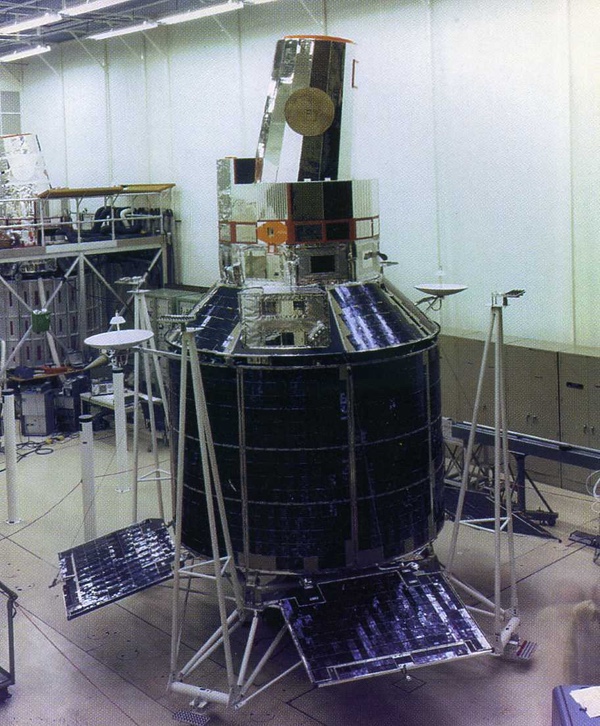The origins and evolution of the Defense Support Program (part 2)DSP gets an upgradeby Dwayne A. Day
|
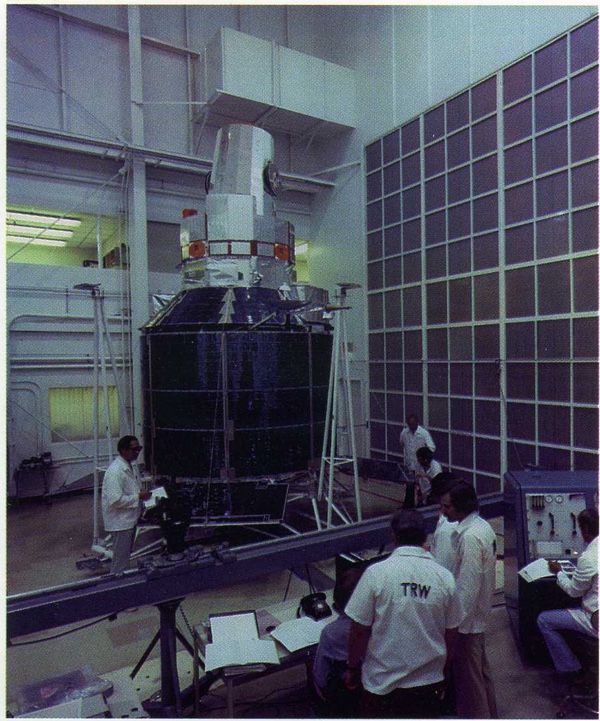 The ninth satellite built was the seventh to reach orbit. Flight 7 was launched in February 1977 and took up station over the Pacific Ocean. From its orbiting location it could detect Soviet submarine-launched ballistic missiles. (credit: USAF) |
Upgrading DSP
By June 1973 the Air Force had approved procurement of 16 satellites, with 12 under contract: the four Phase I satellites had been funded in fiscal year 1966, four Phase II satellites in fiscal year 1970, and four more satellites were approved in fiscal year 1973. By the middle of 1974, Aerojet had already produced four infrared sensors for the next Phase II satellites and had another four under construction. Air Force Space and Missile System Office, which managed DSP procurement, decided to retrofit some of the sensors to improve their performance. Hardware to reduce heating of the focal plane, which proved successful in satellite F-4, was incorporated into several of the sensors then being produced. This prolonged the life of the sensor. A second retrofit, to reduce their susceptibility to transient power losses caused by X-rays produced during nuclear tests, was performed on sensors 10–12.
| The Air Force adopted a policy of replacing an orbiting satellite only when its performance significantly degraded, and usually did so with the newest satellite off the production line, not the earliest one produced. This resulted in satellites 5 and 6 sitting in storage and becoming more obsolete over time. |
In addition, a third sensor modification, to reduce their vulnerability to intentional blinding by Soviet lasers, was also performed. The blinding threat had emerged in the mid-70s after several unexplained “illuminations” of satellite F-2 over the Indian Ocean. But despite early claims, the Pentagon later retreated from its position that a laser had illuminated the satellites, determining that it was possible that they had been blinded by massive gas fires. Nevertheless, program managers were concerned about laser blinding. At this time the Air Force also decided to procure a 13th sensor. This would include a new focal plane produced by the Santa Barbara Research Corporation, which beat out the previous supplier, the Electronics Corporation of America.[2]
The program office also made the decision to develop a new on-board data processor and a new focal plane and cabling. The old data processor was getting increasingly expensive to build and was technologically obsolete. Improving the data processor made further sensor upgrades possible.
While Aerojet was producing and modifying the sensors, TRW continued to supply new spacecraft. Satellites 5 through 9 were essentially identical. But satellites 10 through 12 were to be multi-orbit satellites (MOS) and incorporated a number of significant modifications known as Performance Improvement Modifications (PIM). Collectively, they were to be referred to as the MOS/PIM satellites. The multi-orbit capability was intended to allow the satellites to operate in a Molniya-type highly elliptical orbit (HEO) to close gaps in coverage over northern regions. DSP couldn’t really see beyond 81° N from its geosynchronous perch.
In 1967, the Air Force had begun study of an infrared sensor placed in a highly inclined orbit where it could see the northernmost regions of the Soviet Union and detect the short-burning rocket motors of anti-ballistic missiles (ABMs). Such sensors would serve more of an intelligence collection than missile warning role, collecting measures and signature intelligence (MASINT) on the types of propulsion systems used in Soviet ABMs.
There is information indicating that infrared sensors were placed on signals intelligence satellites known as JUMPSEAT and operated in highly inclined orbits, giving them a view of far northern regions of the Soviet Union. These became operational in the 1970s, but they were intelligence assets, not missile warning assets. The satellite sensors later provided warning data as part of a program known as “DSP-Augmentation,” or DSP-A.[3] (See “From TSCAT to JUMPSEAT: Hughes and the top secret Gyrostat satellite gamble,” The Space Review, December 21, 2020.) Apparently, the missile warning community was not happy with the capabilities provided by these other assets, and this may have prompted the development of the multi-orbit satellite capability for DSP.
The modifications to the DSP satellites to give them a multi-orbit capability remain classified, but other details of the modifications are not. The satellites’ weight increased from 1,043 to 1,170 kilograms. The power output of the main communication channel was increased from 3.5 watts to 20 watts. This allowed the satellites to beam information directly to new small, transportable ground stations. Telemetry antennas were also modified so that they could receive commands from these new stations as well. Power output was increased from 480 to 500 watts. They were nuclear hardened to what was known as JCS [Joint Chiefs of Staff] Level-1.[4]
These design modifications ran into various problems during development, but while work was going forward, the Air Force Space and Missile Systems Office (SAMSO) that oversaw development and procurement asked if the modifications could be retrofitted to satellites 5, 6, and 9. In addition, SAMSO began negotiations to procure a 13th satellite as part of the existing contract. These negotiations were concluded by March 1975. By this time, satellites 5, 6, 7, 8, and 9 had all been completed and were in storage. For reasons that remain unclear, satellites 5 and 6 were to be kept in storage and 7, 8, and 9 were designated as replacements for the then-current constellation.
The Air Force soon faced an unexpected conundrum. SAMSO procured the satellites and then once they were in orbit, Aerospace Defense Command (ADCOM) operated them. Because satellites were lasting longer in orbit than planned, their replacements were being placed into ground storage rather than launched. The Air Force adopted a policy of replacing an orbiting satellite only when its performance significantly degraded, and usually did so with the newest satellite off the production line, not the earliest one produced. This resulted in satellites 5 and 6 sitting in storage and becoming more obsolete over time.
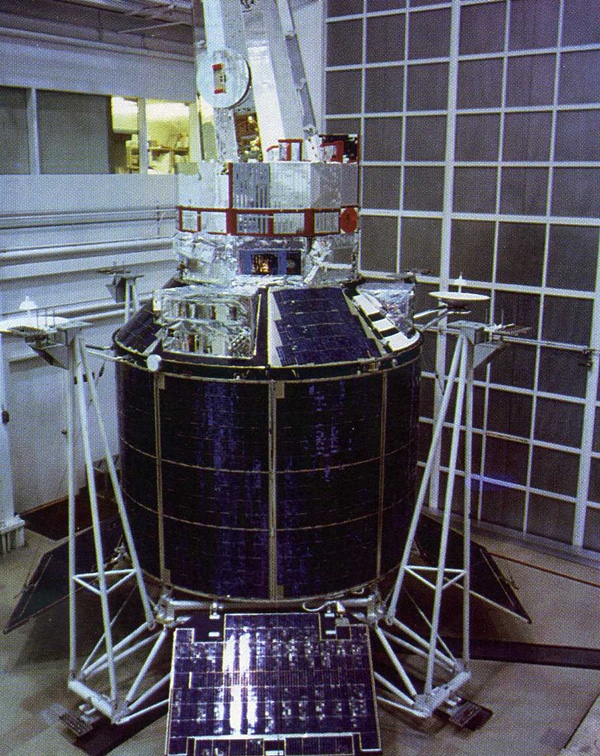 In June 1979 the Air Force launched DSP satellite 11, naming it Flight 8 upon reaching orbit. It took over the Pacific position held by F-7, which moved to take over the Indian Ocean spot from F-2, the oldest satellite in the constellation. Originally designed to last 15 months, F-2 lasted eight years before being relegated to backup status. F-8 was the first of the Multi-Orbit Satellite/Performance Improvement Modifications (MOS/PIM) satellites. Although capable of operating in a highly-inclined/highly-elliptical orbit, all of the MOS/PIM satellites were launched into geosynchronous orbits. (credit: USAF) |
The end of the beginning
By March 1974, satellite F-1, which had been placed in a wayward orbit and was never fully capable of providing the missile warning mission, was shut down when it had run out of propellant for stationkeeping. By July 1975, the remaining three satellites were still operational but had significantly exceeded their design lifetimes. F-2 had already lost one star sensor unit and was experiencing intermittent failures of the backup unit. Loss of the backup would make it impossible for the satellite to determine its precise attitude when it detected a target, therefore making location and tracking of the target impossible as well. In addition, F-2 had lost a digital telemetry unit. Just as importantly, two of the three nuclear burst detector units had failed. If the third failed, one of the satellite’s primary missions would be lost. F-3 had a commanding link receiver fail. Loss of the backup would have made control of the satellite impossible. In addition, a motor bearing failure meant that the satellite had no atmospheric burst locator capability, making it impossible for the satellite to detect nuclear explosions. F-4 had also suffered subcomponent failures in both command link receivers. The satellite had also lost two of its three atmospheric burst locator lamps.[5]
| The Air Force was accumulating a backlog of spare satellites as those on orbit outlasted their design lifetimes. |
Aerospace Defense Command, which had command of the satellites, had two other ground-based radar ballistic missile detection and warning systems. These were the Ballistic Missile Early Warning System (BMEWS) radars, and the 474N Sea-Launched Ballistic Missile Detection and Warning System radars. A fourth system, the Over-the-Horizon Forward-Scatter Radar System (OTH-F), had been inactivated on June 30, 1975. The closure of this system, as well as two submarine-launched ballistic missile (SLBM) warning stations in Laredo, Texas, and Moorestown, New Jersey, had made ADCOM increasingly dependent upon DSP. The Laredo station was particularly important, since it would leave a hole the size of the width of the state of Texas for undetected Fractional Orbital Bombardment System (FOBS) missile launches to fly through. To cover this hole, the Air Force had converted a space tracking radar, known as the FPS-85 and located in Florida, to fulfill the SLBM and FOBS warning role for the southern United States.[6]
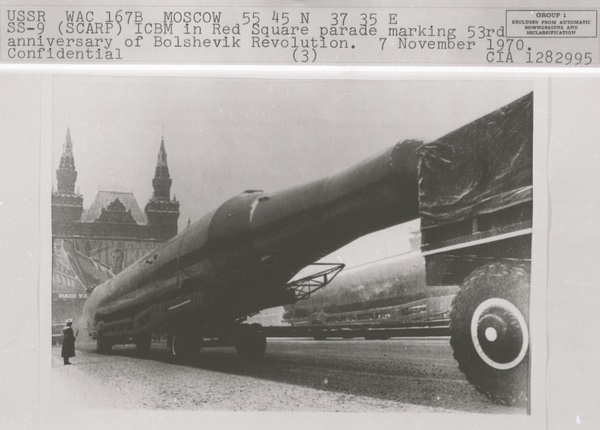 The Soviet SS-9 ICBM was a large missile. This one was photographed by a CIA officer in Moscow in 1970s. One SS-9 variant carried a Fractional Orbital Bombardment System warhead that could attack the United States from the south. DSP satellites were capable of detecting FOBS launches. By the 1970s, the FOBS threat had diminished somewhat. (credit: National Archives) |
DSP Phase II
Concerned about the age of the on-orbit DSP constellation, ADCOM asked for the launch of an additional satellite, the first of the upgraded Phase IIs.
Satellite 7 had been scheduled for a July 25 flight, but this was postponed to improve the reliability of the Titan IIIC booster, which had suffered a failure in May 1975 during the launch of two DSCS II communications satellites. Launch took place on December 14 atop Titan IIIC-29 and satellite 7 successfully attained orbit and was named F-5. But within four days F-5 suffered the most spectacular failure of the program. A malfunctioning heater in the propulsion system had permitted liquid hydrazine in a propellant line to freeze and thaw repeatedly. This ruptured a valve connected to the line and fuel had leaked out through the break and caused the satellite to tumble, spinning at a rate of 50 degrees per second with a tumble rate of seven degrees per second. It spun out of control and there was no way to stop it as the last of its fuel bled off into space. Sometime later the satellite apparently collided with an unknown object which further increased its rate of spin but apparently did no additional damage. Ultimately it was written off as a near-total loss, although several satellite systems continued to function and provided information on their lifetimes. An investigating team narrowed the failure down to several possible causes and steps were taken to correct this problem on the remaining satellites. The team identified between 25 and 30 single-point failures in the satellites, and steps were taken to correct these on the remaining satellites as time and money allowed.[7]
In July 1976, ADCOM changed its designation of orbiting DSP satellites. Prior to that time, the satellites were given a designation consisting of the acronym IRON (Inter-Range Operations Number) and a number. IRON 3165, for instance, was the designation for satellite F-5. After this time, ADCOM itself would refer to the satellites by their flight number, something which SAMSO had done all along.
Meanwhile, the existing constellation continued to age. F-2 and F-3, in addition to the previously mentioned problems, were suffering from rising focal plane temperatures that degraded performance. F-4 was rapidly using up fuel. ADCOM wanted to launch a replacement satellite. This was originally scheduled for April 1976, but slipped to May and then June. On June 26, 1976, satellite 8 was successfully placed in orbit by Titan IIC-28 and named F-6, replacing F-3, which had been monitoring the Atlantic for four years, looking for Soviet submarine-launched ballistic missiles. F-6, the first of the Phase II satellites to become operational, had an additional capability provided by its more advanced sensor: the ability to conduct limited above-the-horizon sensing of targets.
In addition, F-6 had an Advanced RADEC I sensor that was supposed to correct several of the reliability problems with the earlier satellites (failures of the RADEC sensor had been a major worry for ADCOM for all of the earlier satellites) and expand its coverage to include endo-atmospheric nuclear bursts. Although details are classified, the modifications appear to have included the addition of a fourth detector lamp with a slightly shorter and wider cone and mounted on a separate platform. The satellite also had an impact sensor to monitor events like that which had occurred with F-5 after it began tumbling. In October, F-6 suffered a failure of the redundant command link decoder—a problem that had plagued all of the earlier satellites.[8] This was a highly-secret piece of equipment known as the KGP-29A, an encryption device supplied by the National Security Agency. Several KGP-29A units had failed in orbit—the failure apparently was traced to the unit’s power supply—and this had forced the NSA to carefully screen existing units until they could be redesigned.[9] But failures in these units continued.
Another problem occurred with the on-orbit satellites. One of the heaters in F-4’s propellant system malfunctioned, forcing controllers to periodically fire the thruster to keep the fuel from freezing. This shortened the satellite’s lifetime and led the Air Force to decide to launch satellite 9 to replace it. The date for the launch was originally set for May but moved forward to February so as not to interfere with planned launches of communications and signals intelligence satellites also scheduled for May 1977.[10]
Satellite 9 was successfully launched from Cape Canaveral on February 6, 1977 on Titan IIIC-23 and named Flight 7, or F-7. It took up position over the Pacific Ocean. A year before, the Air Force had decided to upgrade satellites 5, 6, 8 and 9 to the same standards as 10-13, including all the MOS/PIM modifications as well as the incorporation of a new sensor. But the failures in orbit meant that satellites 8 and 9 had to be launched before they could be modified, becoming “F-6” and “F-7” in orbit, respectively. By the time F-7 entered orbit, six more satellites were on the ground—5 and 6 were in storage, 10 and 11 would be delivered in November, and 12 and 13 were in production. The Air Force was accumulating a backlog of spare satellites as those on orbit outlasted their design lifetimes. In addition, the longer satellites sat on the ground, the more they became obsolete as new capabilities were incorporated into satellites on the production line. Work was stopped on 12 and 13 in November and they were placed in storage. They were scheduled to be removed later and modified to be compatible with the planned Titan 34D IUS launch vehicle combination.[11]
Production of satellites 10 through 13 was also affected by a serious part problem. Black boxes in the attitude control and power systems of the satellites had failed during tests in July 1975 and January 1977. These failures were found to have been caused by weak bonding in integrated circuits supplied by Teledyne. All suspect parts in these satellites had to be replaced at a cost of $1.5 million.
| DSP soon turned into a highly successful program, but one that required careful management to maximize its potential. |
In the middle of 1977, the DSP constellation was shifted. The Pacific satellite was apparently moved from 105° to 134° West, increasing its coverage of the Pacific Ocean. Also, although there are no confirmed reports of this, an attempt was made to move the Atlantic satellite closer to Europe. It was shifted from 70° to 36° West. But this proved unsuccessful because the Buckley ground station in Colorado experienced problems communicating with the satellite because it was at a low elevation relative to the ground station. Several months later the satellite was shifted back. Another attempt at doing this was made in 1980, but also met with failure and the satellite was again shifted back to its spot at 70° West.[12] It was clear that operating a DSP satellite closer to Europe would require a solution to the communications problem, either a satellite data crosslink, or a new ground station.
The first DSP satellites were designed with lifetimes of 15–19 months. However, in orbit they lasted far longer. The various problems they encountered were rarely the result of design or manufacturing flaws and more often resulted from components wearing out when long past their design lifetimes. In addition, when they experienced problems, ground operators developed fixes or workarounds, and the Air Force delayed launching replacements while they still had useful assets in orbit. DSP soon turned into a highly successful program, but one that required careful management to maximize its potential.
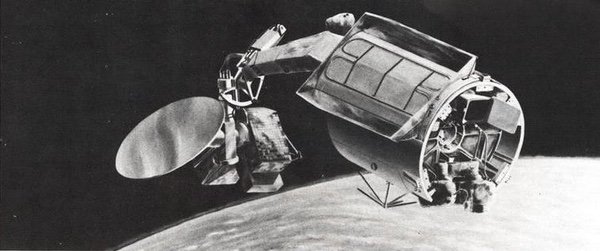 Artist impression of the experimental P-72-2 satellite which carried several sensors to detect infrared targets. One was a scanning sensor (like DSP's infrared sensor) and another was a mosaic sensor. The sensors faced downward. The disk at left and the pan on top of the satellite were radiators. The satellite was launched in 1975 but failed to reach orbit. (credit: USAF) |
DSARC
In February 1980, the Air Force conducted a Defense Systems Acquisition Review Council to address various issues associated with the DSP. Many recommendations came out of this study, including the goal to reduce dependence upon the Overseas Ground Station in Australia by providing the satellites with a crosslink capability, and the need to reduce dependence upon relays to transmit satellite data to tactical ground receivers.
In December 1979, Air Force Space Division had gone before the DSARC to ask for permission to develop a radically different “DSP II” satellite using new sensor technology. There were inherent limitations in the technology then in use. Space Division wanted a new satellite to use mosaic or “staring” arrays, which provided far greater accuracy and faster data return since a target’s position and trajectory did not have to be built up with successive passes of the linear sensor array. DSARC rejected this request, determining that the technology was too risky. Space Division was directed to continue technology research on mosaic sensors and combine its efforts with similar work sponsored by the Defense Advanced Research Projects Agency.[13] DSARC, however, did approve a much-upgraded DSP system beginning with satellite 14. But even before this decision, the Air Force had been undertaking numerous efforts to better understand the different types of infrared targets and to produce better hardware to detect them.
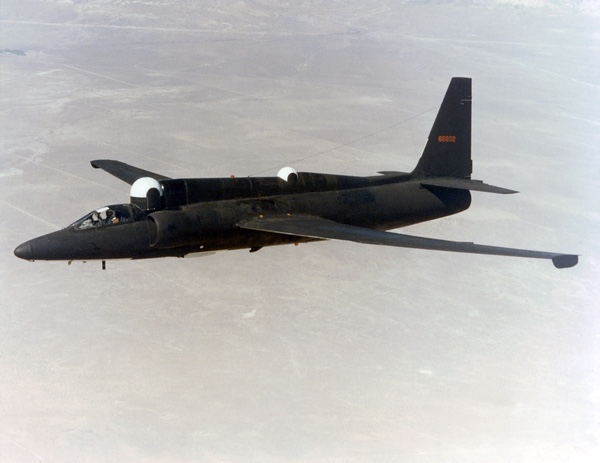 A U-2 reconnaissance aircraft carrying two infrared sensors as part of the Target Radiant Intensity Measurement Program (TRIM) in late 1971. TRIM's purpose was to obtain better data on the characteristics of various ballistic missile targets. (credit: Jim Goodall via Chris Pocock) |
Improving the infrared sensors
Sensor modifications had already been part of an on-going experimental program. A satellite borne instrumentation package designated RM-19 had flown aboard a classified STRAWMAN signals intelligence satellite launched on July 16, 1971. Later in that year, a modified U-2 aircraft began flying with a special sensor package known as TRIM, for Target Radiant Intensity Measurement Program. TRIM flights fell under the overall name Project Chaser and were conducted from October 1971 until June 1974 from a classified base. Modifications were then made to the sensor and flights were resumed.[14]
In addition to the TRIM flights, a Space Test Program satellite named P 72-2 was built and equipped with two infrared radiometers known as RM-20A and RM-20B. RM-20A was a scanning sensor and RM-20B was a mosaic sensor. The former was built by Lockheed Missiles and Space Company and the latter by Rockwell International/Space Division, which also built the satellite. Unfortunately, the P 72-2 satellite, launched April 12, 1975, never achieved orbit. A later evaluation by the DSP program office about whether to continue RM-20 experiments concluded that the RM-20 program had gotten off-track and was better suited to hardware development than measurements and evaluation of infrared sources. The program office elected instead to pursue a two-part program to evaluate follow-on technologies. The first part would utilize suborbital rocket launches, balloons, and aircraft, whereas the second part would utilize satellites.[15]
While this was underway, Aerojet was working on an improved sensor for later satellites. One of the problems experienced with the early DSP satellites was that the sensor lost its sensitivity over time. Gradually, the temperature of the focal plane would rise and background radiation in the satellite itself would wash out signals detected by the sensor—targets would fade into the noise produced by the less sensitive sensor. F-4 and later satellites incorporated modifications in the sensor to improve their lifetimes, but further improvements were possible.
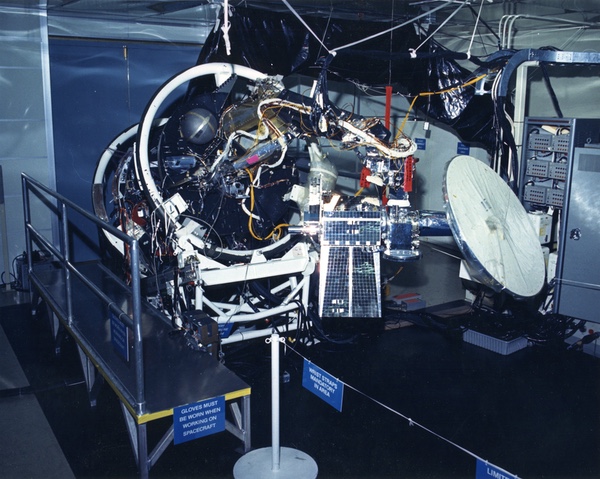 The P 72-2 satellite undergoing final testing. The satellite was equipped with several instruments that were intended to lead to better infrared sensors for the Defense Support Program. After the satellite failed to reach orbit in 1975, an investigation team criticized the satellite for being more focused on hardware development than gathering data to improve DSP. (credit: USAF) |
The program to upgrade the sensor grew out of three separate studies begun in 1975. In January 1976 these were all combined into a single program known as the Sensor Evolutionary Development (SED) program.[16] The new sensor would incorporate an improved focal plane, onboard processor, and thermal control unit. It would have a five-year design life versus three for the earlier sensors. The focal plane itself was to be the most radically redesigned part of the sensor. The sensor for the previous satellites used lead sulfide in the detectors. Aerojet planned to replace this with mercury cadmium telluride, which offered higher performance and lower cost.[17] These improvements would give the sensor longer life and better surveillance capability. Aerojet began designing this new sensor in the spring of 1977 and had begun engineering models of the components by the end of the year.
| Although missile launch detection was the DSP’s primary mission, their other main mission was detection of nuclear explosions. The new satellites were to be equipped with a new nuclear explosion detector. |
The Air Force decided to incorporate the new sensor into satellites 14 and on and retrofit it into numbers 5 and 6, then in storage. This required improvements in the satellites’ pointing accuracy, their power output, and the momentum of their reaction wheels. Besides these changes, satellites 5 and 6 were also scheduled to undergo several changes similar to the PIM program, such as an increase in the power of the communications downlink, made to enable them to receive commands even when the signal was jammed.
Although missile launch detection was the DSP’s primary mission, their other main mission was detection of nuclear explosions. The new satellites were to be equipped with a new nuclear explosion detector known as Advanced RADEC I. In addition, the satellites were to be modified to be compatible with both the space shuttle and the Inertial Upper Stage (IUS). One of the modifications for use of the IUS was the development of protective covers for the satellite. Unlike the liquid-fueled Transtage used on previous launches, the IUS had a solid motor that would produce contaminants when shutting down. These contaminants could coat optics and sensors in the satellites and it was therefore necessary to cover them during flight—the covers would be ejected after the satellite had separated from the IUS. The early planning for the modifications was made beginning in March 1977.
The most advanced of the modifications, the use of the new material in the focal plane, proved to be a major problem. Honeywell Electrooptics Company was the focal plane subcontractor and was unable to produce mercury cadmium telluride detector modules with the required sensitivity and stability. In May 1978, after a review of Honeywell’s progress, Aerojet decided to switch back to lead sulfide detectors. The new focal plane would still have greatly improved performance through the addition of 4,000 detectors, bringing the total to 6,000. This would give them much increased resolution and global coverage, enabling the satellites to predict missile launch locations and trajectories with greater precision.[18] This latter capability was significant, for it allowed nuclear war fighters to determine which Soviet silos still had missiles in them and target them accordingly.
Unfortunately, Honeywell also ran into problems with the signal electronics used in the sensor. This pushed back the schedule for development of test hardware for the new sensor and caused Aerojet to overrun its budget of $47 million by nearly $5 million.
While the development of the advanced hardware continued, satellites 12 and 13 were removed from storage and modified to equip them with Advanced RADEC I and to make them compatible with the Titan 34D/IUS. A new sensor, known as Advanced RADEC II, was also added. AR II consisted of four sensors mounted on the solar paddles as well as one or more mounted on the exterior of the instrument module to detect nuclear explosions in space.
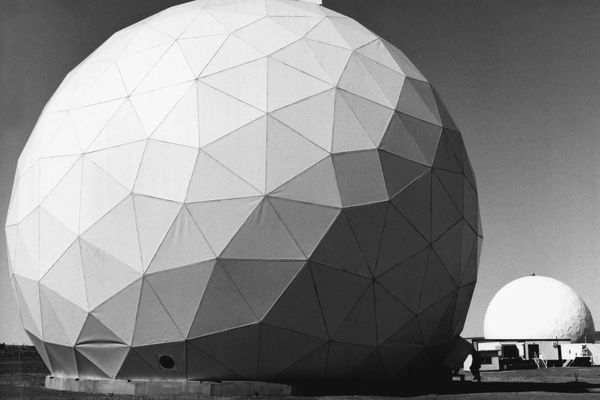 Radomes at the DSP Overseas Ground Station at Nurrungar, Australia. Nurrungar was a key site for receiving data from a DSP satellite that viewed the primary Soviet ICBM launching areas. Late in 1980 the site experienced power outages that resulted in part of the DSP constellation being non-operational. Nurrungar also became the focus of political protests in Australia, and American defense officials sought ways to reduce reliance upon the base. (credit: Australian Defence Department) |
Shifting the constellation again and the notorious F-9
While design and development of the new infrared sensor was proceeding, satellite 11 was taken out of storage in early January 1979 and tested before being shipped to Cape Canaveral in April. It was scheduled for launch in May, but a problem with the booster postponed this by a month. On June 10, it was launched atop Titan IIIC-33. Once in orbit it was designated Flight 8. It was placed in operation on June 22, and formally turned over to the Aerospace Defense Command (ADCOM) on July 11. F-8 was the first of the MOS/PIM satellites to fly. It replaced F-7, which was moved to replace F-2, then the Indian Ocean satellite. F-2 was designated Limited Reserve Satellite and assigned a back-up slot at 75° East. Originally designed to last 15–19 months, F-2 had been in service for eight years.
Late in 1980, the ground station at Nurrungar in Australia began experiencing problems with the power supply to its computers. Several unscheduled outages occurred. The use of test software also caused NORAD to declare the DSP East station “non-operational” for several hours on November 27. On at least one occasion these unscheduled outages led to the activation of the ground-based segment of the DSP-Augmentation system. DSP-A involved the use of several space-based systems as well as ground-based surveillance and missile tracking stations, including the FPS-17 and FPS-79 detection and tracking radars at Diyarbakir, Turkey, the Cobra Dane radar on Shemya Island, Alaska, and the BMEWS sites at Clear, Alaska and Thule, Greenland.
Also, sometime in 1980, another on-orbit satellite, F-6 over Brazil and focusing on the Atlantic Ocean, started to degrade as temperatures rose in its focal plane, and the Air Force decided to replace it with satellite 10, then in storage. The satellite was shipped to the Cape in early January 1981 and scheduled for launch in mid-February. Again a problem with the booster caused a one-month delay, but the satellite was successfully launched atop Titan IIIC 23-C-22 on March 16, 1981. Once in orbit, the satellite was designated Flight 9 and took over the Atlantic spot from F-6, which was shifted to become Limited Reserve Satellite for the Eastern Hemisphere at 75° East, at which time F-2 was finally discarded. F-6 had been in operational use for five years.
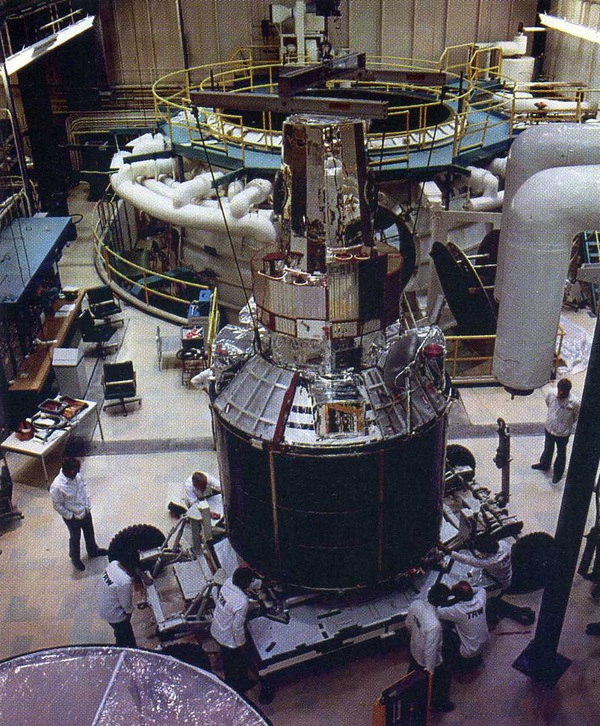 Satellite 10 was launched in March 1981 and named F-9 in orbit, taking over the Atlantic spot from F-6. Flight 9 suffered numerous problems during its early operations, and was taken out of operational service for some time in order to undergo further on-orbit testing. Eventually, the Overseas Ground Station at Nurrungar in Australia developed special procedures for operating it in orbit. (credit: USAF) |
After initial testing, F-9 was turned over to Aerospace Defense Command. However, its performance was less than satisfactory—the satellite suffered from numerous problems with its infrared sensor—and ADCOM returned control of the satellite to Space Division for continued testing. This was to be a bad omen for F-9.[19]
| Although satellites 5, 6, 8, 9, and 10–13 had all been modified to include the multi-orbit-satellite capability, none of them were ever launched into a higher inclination orbit, and there is no information indicating if the Air Force ever considered this. |
The infrared sensors on the DSP satellites were susceptible to numerous spurious reflections and flare/glare problems due to ground terrain (for instance, snow and ice cover), atmospheric effects like cloud cover, and annual changes in the satellite’s attitude toward the sun. All of these effects could be handled to some extent through software modifications. Certain spots on the Earth were automatically or manually blanked out. The annual rotation of the Earth around the Sun created periods during which the satellites were less capable of detecting launches. These flare/glare spots could lead to internal reflections within the sensor—a problem that for inexplicable reasons was particularly acute on F-9.
Further troubles occurred when both of the star sensors on the relatively new F-8—used to determine satellite attitude—failed by July 1981. On March 6, 1982, satellite 13 was launched into orbit atop Titan IIIC 23-C-20 and designated F-10. It replaced F-9, then over the Atlantic Ocean. F-9, in turn, was shifted to replace F-8 over the Pacific. F-8 was designated as the Limited Reserve Satellite for the Western Hemisphere and shifted to 85° West. F-10 proved to be skittish in operation, experiencing erratic performance in its downlink transmission speeds, which tended to cause problems with ground equipment.
On April 14, 1984, satellite 12 was launched into orbit atop Titan 34D-11 and designated F-11. It replaced F-9 over the Pacific, with F-9 being moved to take the place of F-7 over the Indian Ocean. F-7 had begun suffering problems with its reaction wheel. The reaction wheel was designed to counteract the torque produced by the rotation of the satellite by spinning in the opposite direction. Problems with the reaction wheel as well as the satellite’s data link caused ADCOM to ask that F-7 be replaced by a new satellite. F-9 assumed this duty and F-7 was designated the backup satellite at 75° East.
In May of 1984, however, F-9 suffered serious anomalies. Unlike the earlier problems with the difficult sensor, these problems included a fuel leak as well as problems with the KGP-29A encryption unit.[20] By June 28, the second power supply to the encryption unit had failed and the satellite was inoperative—leaving the United States without missile warning coverage of the primary missile fields of the Soviet Union. The Air Force decided to move satellite F-7, then on LRS status at station between the Pacific and Indian Ocean satellites, to F-9’s station in early July. The ultimate solution to F-9’s problem was for the Nurrungar Overseas Ground Station to develop a “fly-by-wire” capability in which the satellite’s attitude was continuously monitored and controlled. Although ground controllers thought they had the problem fixed in early October, problems persisted, and it wasn’t until November 9 that the satellite was restored to fully operational status. All this time, the only satellite observing Soviet missile fields had been the obsolete F-7, whose sensor had badly degraded over time and whose reaction wheel made it unreliable.
Although satellites 5, 6, 8, 9, and 10–13 had all been modified to include the multi-orbit-satellite capability, none of them were ever launched into a higher inclination orbit, and there is no information indicating if the Air Force ever considered this. In fact, there is still limited information on why the MOS capability was ever included in the satellites. Was there an intelligence requirement or concern about potential anti-satellite weapons? Perhaps the space and ground-based DSP-Augmentation systems were deemed sufficient to provide coverage of northern latitudes and any requirement for a Molniya-based DSP satellite abated. Once F-11 was on-orbit, only two satellites were left on the ground. DSP satellites 5 and 6 had been delivered to the Air Force in 1973 and 1974.[21] Ten years later, they had been extensively retrofitted, redesignated 5R and 6R, but had still not flown. Problems with F-9 and the other satellites in the constellation led ADCOM to call for one of these satellites to finally be launched, a decade after it was built.
Next: Satellites 5R and 6R finally fly, and the debut of DSP-1.
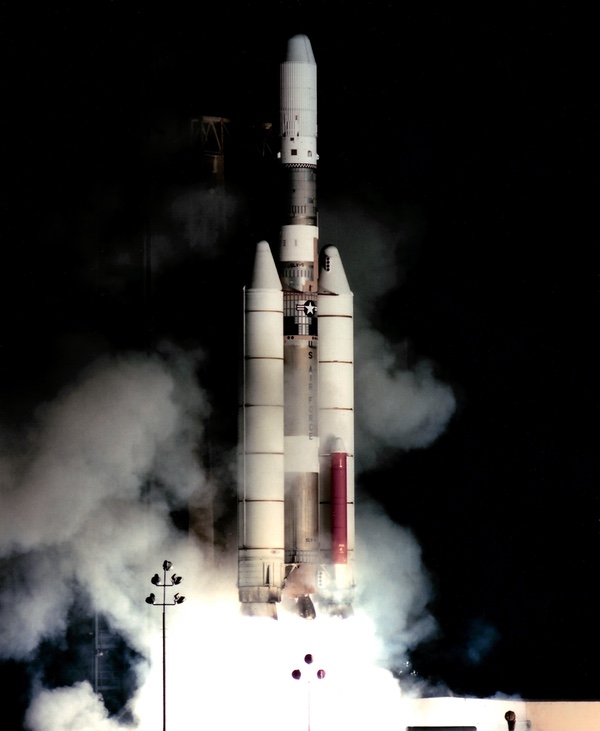 A Titan rocket launched on June 26, 1976 from Florida carrying the DSP Flight 6 satellite. The satellite took up position over the Atlantic Ocean. (credit: USAF) |
References
- History of Space and Missile Systems Organization, 1 July 1972-30 June 1973, Robert J. Smith, Timothy C. Hanley, Capt. Lothar P. de Temple, Robert F. Piper, Dr. John T. Greenwood, SAMSO History Office, p. 127. Contained in NASA History Division, Reference Collection files: “Air Force Satellites: DSP.”
- History of Space and Missile Systems Organization, 1 July 1973-30 June 1975 Dr. Thomas S. Snyder, Timothy C. Hanley, Robert J. Smith, SSgt. Ronald Benesh, Lt.Colonel Earl Goddard, SAMSO History Office, pp. 317-321. Contained in NASA History Division, Reference Collection files: “Air Force Satellites: DSP.” For more on the blinding issue see: Jeffrey T. Richelson, America’s Space Sentinels: DSP Satellites and National Security (2nd edition), University Press of Kansas, 2012, pp. 76-77.
- See Richelson, p. 74.
- Col. J. Kidd and 1Lt. H. Caldwell, “Defense Support Program: Support to a Changing World,” paper presented at American Institute for Aeronautics and Astronautics Space Programs and Technologies Conference, March 24-27, 1992, AIAA 92-1518.
- History of Aerospace Defense Command, 1 July-31 December 1975, p. 48-51. Contained in Space Policy Institute Collection.
- Paul Bracken, The Command and Control of Nuclear Forces, Yale University Press, New Haven, 1983, p. 37.
- History of Space and Missile Systems Organization, 1 July 1975-31 December 1976, Thomas S. Snyder, Timothy C. Hanley, Elizabeth J. Levack, Lt. Col. Earl Goddard, SAMSO History Office, pp. 194-196. Contained in NASA History Division, Reference Collection files: “Air Force Satellites: DSP.”
- History of Aerospace Defense Command, 1 January-31 December 1976, p. 114. Contained in Space Policy Institute Collection.
- History of Space Division, 1 October 1981-30 September 1982, Dr. Timothy C. Hanley, Dr. Harry N. Waldron, and Elizabeth J. Levack, Space Division History Office, p. 215. Contained in NASA History Division, Reference Collection files: “Air Force Satellites: DSP.”
- Ibid., pp. 198-199.
- History of Space and Missile Systems Organization, 1 January-31 December 1977, Timothy C. Hanley, Harry N. Waldron, Thomas S. Snyder, Elizabeth J. Levack, p. 236. Contained in NASA History Division, Reference Collection files: “Air Force Satellites: DSP.”
- Lieutenant Colonel A. Andronov and Captain S. Garbuk, “U.S. IMEWS Space System and Creation of an Advanced Ballistic Missile Launch Detection System,” 95UM0227E Moscow ZARUBEZHNOYE VOYENNOYE OBOZRENIYE in Russian No 12, 1994 (signed to press 8 Dec 94) pp. 34-40, English translation in JPRS-UMA-95-011.
- History of Space Division, 1 October 1980-30 September 1981, Timothy C. Hanley, Harry N. Waldron, and Elizabeth J. Levack, Space Division History Office, pp. 315-316. Contained in NASA History Division, Reference Collection files: “Air Force Satellites: DSP.” For more on DSARC, see Richelson, pp. 88-89.
- History of Space and Missile Systems Organization, 1 July 1973-30 June 1975 Dr. Thomas S. Snyder, Timothy C. Hanley, Robert J. Smith, SSgt. Ronald Benesh, Lt.Colonel Earl Goddard, SAMSO History Office, pp. 362-365. Contained in NASA History Division, Reference Collection files: “Air Force Satellites: DSP.”
- Ibid., pp. 366-369.
- History of Space and Missile Systems Organization, 1 July 1975-31 December 1976, Thomas S. Snyder, Timothy C. Hanley, Elizabeth J. Levack, Lt. Col. Earl Goddard, SAMSO History Office, p. 202. Contained in NASA History Division, Reference Collection files: “Air Force Satellites: DSP.”
- History of Space and Missile Systems Organization, 1 January-31 December 1978, Timothy C. Hanley, Harry N. Waldron, Helena A. Behrens, Elizabeth J. Levack, SAMSO History Office, p. 224. Contained in NASA History Division, Reference Collection files: “Air Force Satellites: DSP.”
- History of Space Division, 1 October 1980-30 September 1981, Timothy C. Hanley, Harry N. Waldron, and Elizabeth J. Levack, Space Division History Office, pp. 303-304. Contained in NASA History Division, Reference Collection files: “Air Force Satellites: DSP.”
- History of Aerospace Defense Command, January-December 1984, p. 56. Contained in Space Policy Institute Collection.
- History of Space and Missile Systems Organization, 1 July 1973-30 June 1975 Dr. Thomas S. Snyder, Timothy C. Hanley, Robert J. Smith, SSgt. Ronald Benesh, Lt.Colonel Earl Goddard, SAMSO History Office, p. 324. Contained in NASA History Division, Reference Collection files: “Air Force Satellites: DSP.”
- History of Space Division, 1 October 1982-30 September 1983, Dr. Timothy C. Hanley, Dr. Harry N. Waldron, and Elizabeth J. Levack, Space Division History Office, p. 209. Contained in NASA History Division, Reference Collection files: “Air Force Satellites: DSP.”
Note: we are using a new commenting system, which may require you to create a new account.
